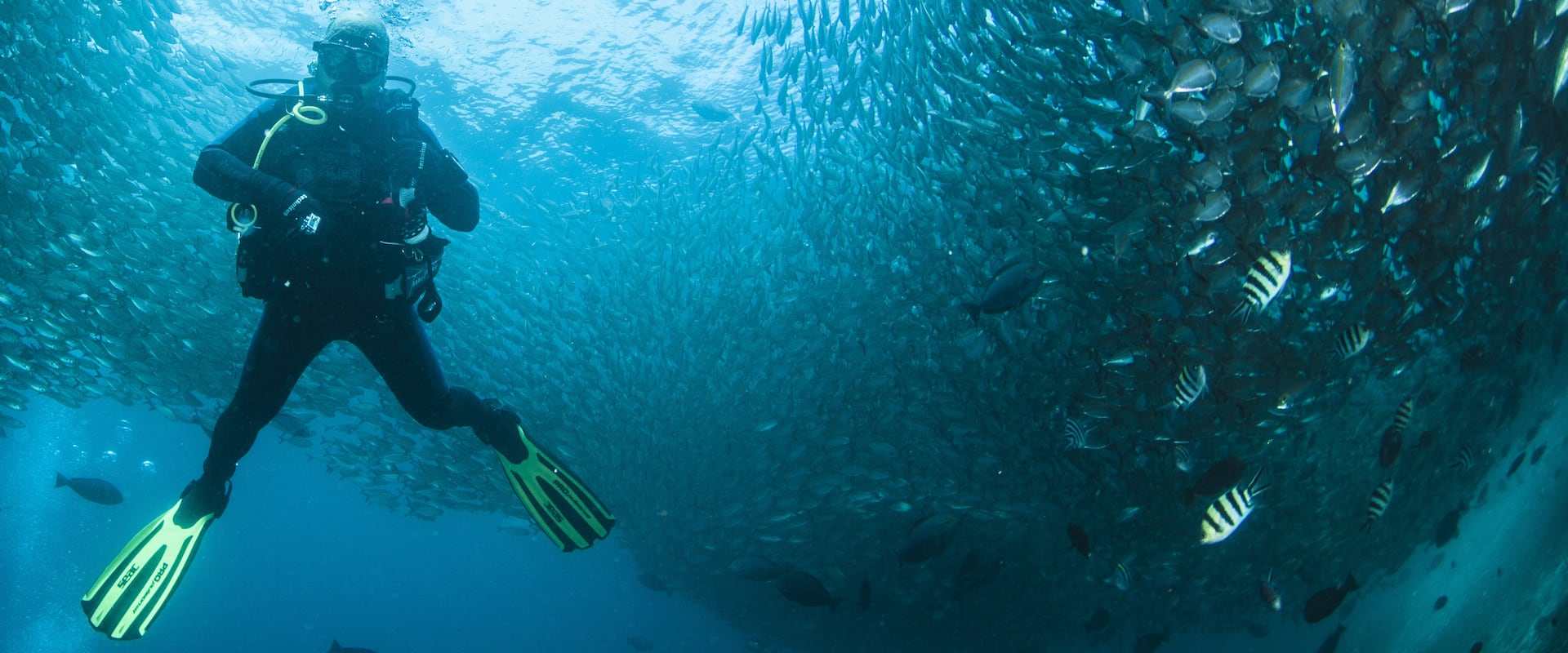Liveaboard Diving in Dampier Strait
What To Expect On A Dampier Strait Liveaboard
Dampier Strait liveaboards visit this stretch of water that sits between two of the larger of the Raja Ampat islands, Waigeo and Batanta. The strait is named after the British navigator William Dampier who charted much of the region around the Raja Ampat islands and Papua during the 17th century.
The region was subject to a fair amount of military activity during the Second World War. The allied planes even bombed one of the small islets in the strait. From the air the phenomenal currents were mistaken for a submarine wake and a completely uninhabited island was heavily bombed.
The underwater topography and the fact that it is between two larger islands means that the currents are very strong. The currents bring plankton rich waters up from the deep which attracts a huge number of fish and bigger pelagics to the strait. A good selection of liveaboards visit Dampier Strait as part of a Raja Ampat dive itinerary.
Dampier Strait Underwater
The position that the Dampier Strait is in means that the currents are plankton rich and full of fish life. The reefs are excellent because like the rest of the Raja Ampat islands the Dampier Strait is inside of the coral triangle. The dive sites are normally caked with corals full of critters and beautiful reef fish.
Dampier also enjoys particularly good conditions for divers to see some bigger animals. Mantas are frequently seen here on liveaboard dive cruises, sometimes in large numbers. It is not unusual to see groups of them swimming in the current, mouths wide open feeding on plankton. They also come down close to the reefs which makes this a top photography and videography opportunity.
Mantas aren’t the only bigger fish on offer here with white and black tipped reef sharks to be found sleeping on the reefs. During the day is a good time to look out for them hiding under rocks with their conspicuous tails sticking out. Wobbegong sharks can also be seen camouflaging themselves on the bottom, resting during the day. They are a fascinating shark and their strange bearded chins make a great macro shot.
Dive Sites of Dampier Strait
There are a number of excellent dive sites visited by liveaboards in the Dampier Strait, but for fish life none come close to Sardine Reef. Oddly there aren’t any sardines but there is no shortage of fish here to make up for it. This is the kind of place where you will be surrounded by amazing shoals of trevallies for the whole dive. Don’t let that distract you from the Wobbegong sharks that are lurking on the bottom though. Nearby, Cape Kri is also crowded with fish shoals and you can also see barracuda hanging about.
Many divers join liveaboards to Raja Ampat to see the mantas and Manta Sandy in the Dampier Strait is the place to catch them. The currents mean there is plenty of food for them here and it isn’t unusual for them to swim near to the sandy bottom. Photographers should have their cameras ready for a close-up.
Top Tips for Divers
- The conditions in the Dampier Strait mean that this is not really a good dive area for new divers.
- Heavy current on the dive sites can be very strong so a few extra lanyards would be a good idea.
- The entire region is quite isolated and there are not so many facilities, so make sure you bring ample spares with you.
Getting to the Dampier Strait
Reaching the Dampier Strait area requires some time and a few different modes of transport. The airport in Sorong in West Papua is the closest to the Raja Ampat islands. There are no international flights to this airport but you can get there from Jakarta and Singapore. There are some ferries from Sorong to the islands but most divers opt for a diving cruise.
Indonesian liveaboards typically start in Sorong and take from a week to two weeks to visit the best dive sites in the region. There are different kinds of diving liveaboards available to suit various styles and budgets. The conventional motor vessels customised as dive boats offer comfortable accommodation and a smooth diving experience. For a more unique experience many divers enjoy the traditional Indonesian sailing boats. These beautiful vessels are a peaceful and traditional way to enjoy the islands.
Dampier Strait Diving Reviews
- 9.3 Superb
- 9.2 Superb
- Sehoya C
United States
amazing, with unparalleled diversity of fish, coral, and other sea life.
Diving Dampier Strait in November on the Aurora
- 10.0 Exceptional
- Zachary L
United States
Enjoyed some dives more than others but all were extremely varied and filled with fish and life.
Diving Dampier Strait in February on the Jaya
- 9.6 Exceptional
- Thomas O
United States
Sad compared to previous dive trips.
Diving Dampier Strait in February on the Ilike
- 10.0 Exceptional
- Judi R
United States
Great! You must be experienced in heavy current. We were there on a new moon and the currents are stronger at a full and new moon.
Diving Dampier Strait in January on the Mutiara Laut
- 9.2 Superb
- Emily L
United States
Great visibility and lots of variety of corals and fish.
Diving Dampier Strait in December on the Seahorse
- 5.6 Review score
- Sue S
United States
Strong currents and low viz.
Diving Dampier Strait in November on the Seaisee
- 9.6 Exceptional
- JARED V
United States
Great, quite varied - a lot of different types and kinds o dives.
Diving Dampier Strait in August on the Coralia
- 9.6 Exceptional
- Charles M
United States
Amazing, so much diversity and always something to see
Diving Dampier Strait in March on the Epica
- 9.2 Superb
- Garrett W
United States
Excellent, but the visibility could have been better
Diving Dampier Strait in December on the Ambai
- 9.6 Exceptional
- Ann K
United States
The Dampier Strait, though more touched by people’s presence, was really great diving. The night dives there, in particular, were superior. I’ve done 400 dives, and I’ve seen things I never saw before there.
Diving Dampier Strait in December on the Samambaia











